Introduction to Qualitative Research: Methods, Ethics, and Analysis
VerifiedAdded on 2023/01/04
|6
|1331
|54
Homework Assignment
AI Summary
This assignment provides a comprehensive introduction to qualitative research, exploring various methods and strategies. It begins by defining qualitative research and differentiating it from quantitative approaches, highlighting its focus on non-numerical data and in-depth insights. The assignment then delves into specific strategies, including ethnography, narrative analysis, grounded theory, and case studies, explaining their applications. It also details typical sources of qualitative data such as interviews, focus groups, observations, and action research. Furthermore, the assignment covers specific research designs like case studies, content analysis, mixed method research, and action research. Finally, it emphasizes the ethical principles crucial to qualitative research, including minimizing harm, obtaining informed consent, protecting confidentiality, avoiding deception, and respecting the right to withdraw. The assignment is well-structured, providing clear explanations and examples to facilitate understanding of the subject matter.

Introduction to qualitative research
Paraphrase This Document
Need a fresh take? Get an instant paraphrase of this document with our AI Paraphraser
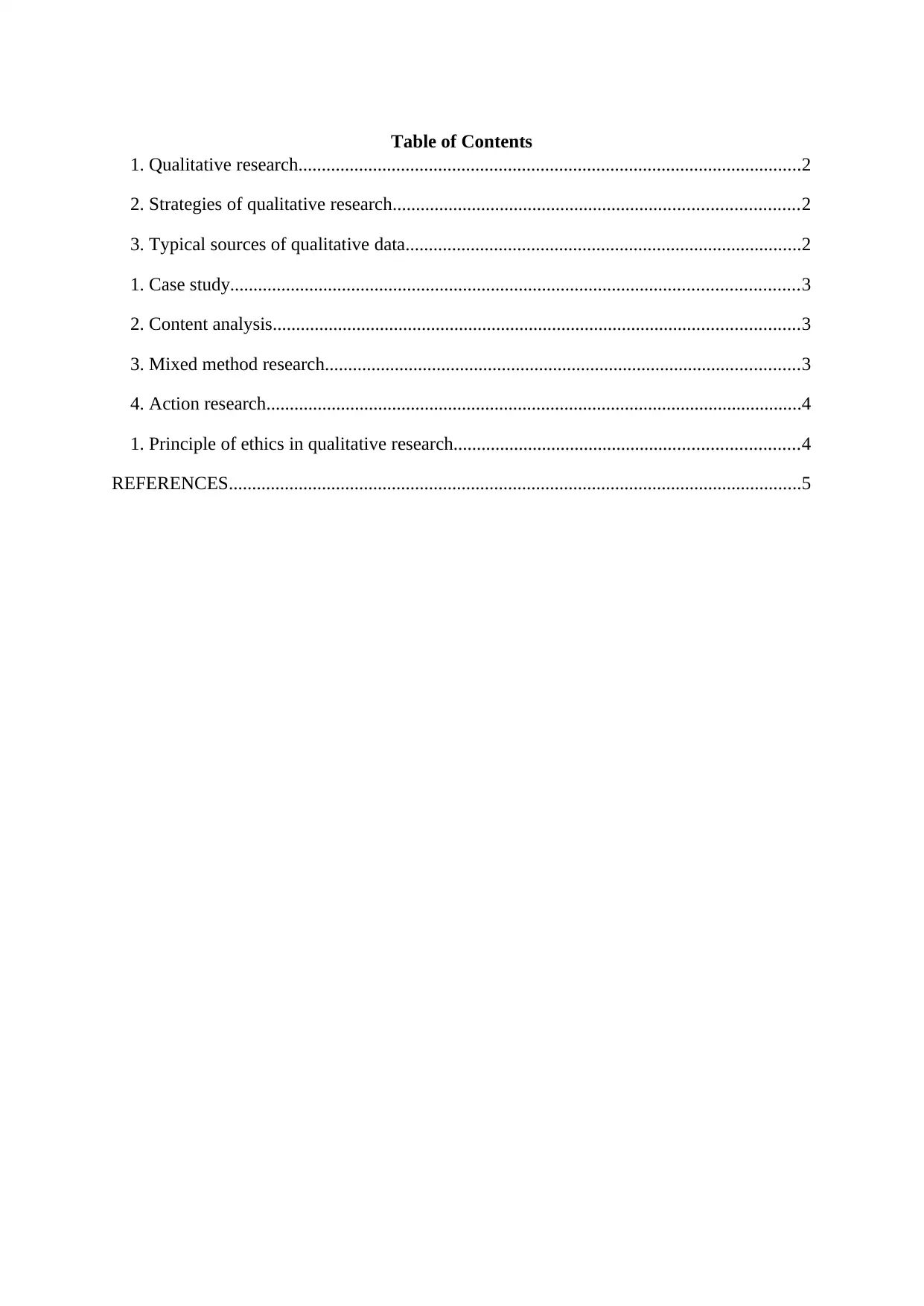
Table of Contents
1. Qualitative research............................................................................................................2
2. Strategies of qualitative research.......................................................................................2
3. Typical sources of qualitative data.....................................................................................2
1. Case study..........................................................................................................................3
2. Content analysis.................................................................................................................3
3. Mixed method research......................................................................................................3
4. Action research...................................................................................................................4
1. Principle of ethics in qualitative research..........................................................................4
REFERENCES...........................................................................................................................5
1. Qualitative research............................................................................................................2
2. Strategies of qualitative research.......................................................................................2
3. Typical sources of qualitative data.....................................................................................2
1. Case study..........................................................................................................................3
2. Content analysis.................................................................................................................3
3. Mixed method research......................................................................................................3
4. Action research...................................................................................................................4
1. Principle of ethics in qualitative research..........................................................................4
REFERENCES...........................................................................................................................5
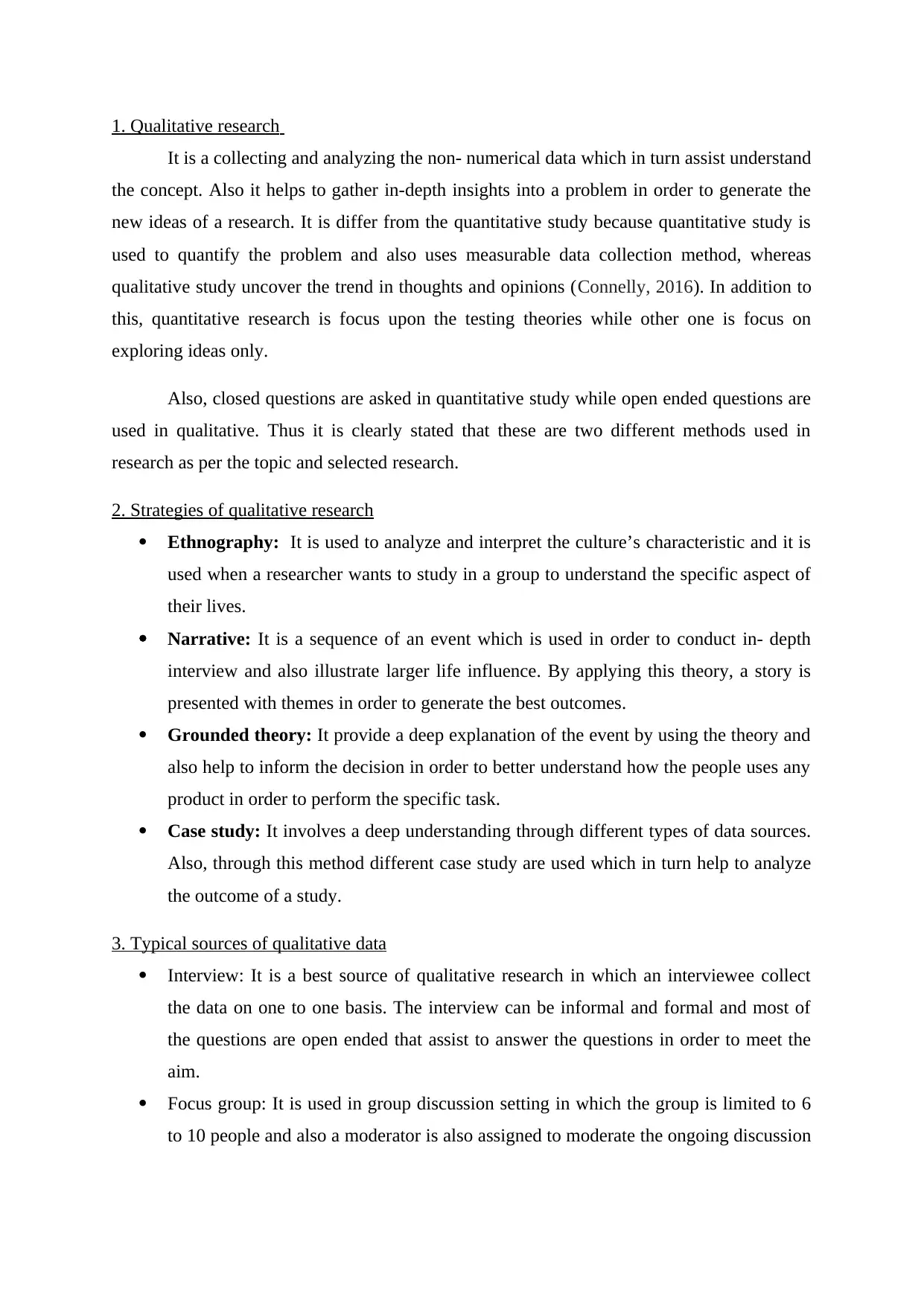
1. Qualitative research
It is a collecting and analyzing the non- numerical data which in turn assist understand
the concept. Also it helps to gather in-depth insights into a problem in order to generate the
new ideas of a research. It is differ from the quantitative study because quantitative study is
used to quantify the problem and also uses measurable data collection method, whereas
qualitative study uncover the trend in thoughts and opinions (Connelly, 2016). In addition to
this, quantitative research is focus upon the testing theories while other one is focus on
exploring ideas only.
Also, closed questions are asked in quantitative study while open ended questions are
used in qualitative. Thus it is clearly stated that these are two different methods used in
research as per the topic and selected research.
2. Strategies of qualitative research
Ethnography: It is used to analyze and interpret the culture’s characteristic and it is
used when a researcher wants to study in a group to understand the specific aspect of
their lives.
Narrative: It is a sequence of an event which is used in order to conduct in- depth
interview and also illustrate larger life influence. By applying this theory, a story is
presented with themes in order to generate the best outcomes.
Grounded theory: It provide a deep explanation of the event by using the theory and
also help to inform the decision in order to better understand how the people uses any
product in order to perform the specific task.
Case study: It involves a deep understanding through different types of data sources.
Also, through this method different case study are used which in turn help to analyze
the outcome of a study.
3. Typical sources of qualitative data
Interview: It is a best source of qualitative research in which an interviewee collect
the data on one to one basis. The interview can be informal and formal and most of
the questions are open ended that assist to answer the questions in order to meet the
aim.
Focus group: It is used in group discussion setting in which the group is limited to 6
to 10 people and also a moderator is also assigned to moderate the ongoing discussion
It is a collecting and analyzing the non- numerical data which in turn assist understand
the concept. Also it helps to gather in-depth insights into a problem in order to generate the
new ideas of a research. It is differ from the quantitative study because quantitative study is
used to quantify the problem and also uses measurable data collection method, whereas
qualitative study uncover the trend in thoughts and opinions (Connelly, 2016). In addition to
this, quantitative research is focus upon the testing theories while other one is focus on
exploring ideas only.
Also, closed questions are asked in quantitative study while open ended questions are
used in qualitative. Thus it is clearly stated that these are two different methods used in
research as per the topic and selected research.
2. Strategies of qualitative research
Ethnography: It is used to analyze and interpret the culture’s characteristic and it is
used when a researcher wants to study in a group to understand the specific aspect of
their lives.
Narrative: It is a sequence of an event which is used in order to conduct in- depth
interview and also illustrate larger life influence. By applying this theory, a story is
presented with themes in order to generate the best outcomes.
Grounded theory: It provide a deep explanation of the event by using the theory and
also help to inform the decision in order to better understand how the people uses any
product in order to perform the specific task.
Case study: It involves a deep understanding through different types of data sources.
Also, through this method different case study are used which in turn help to analyze
the outcome of a study.
3. Typical sources of qualitative data
Interview: It is a best source of qualitative research in which an interviewee collect
the data on one to one basis. The interview can be informal and formal and most of
the questions are open ended that assist to answer the questions in order to meet the
aim.
Focus group: It is used in group discussion setting in which the group is limited to 6
to 10 people and also a moderator is also assigned to moderate the ongoing discussion
⊘ This is a preview!⊘
Do you want full access?
Subscribe today to unlock all pages.

Trusted by 1+ million students worldwide
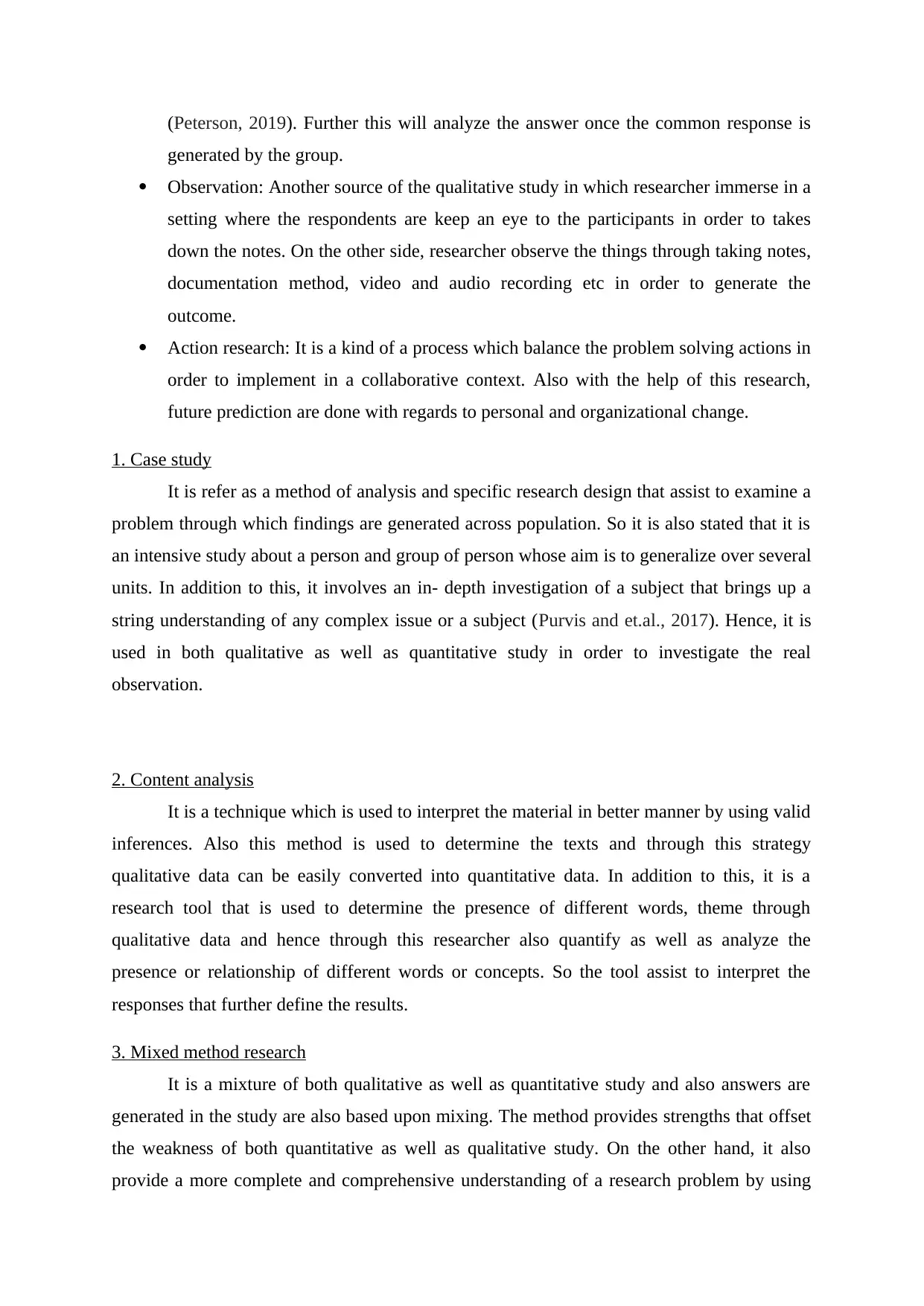
(Peterson, 2019). Further this will analyze the answer once the common response is
generated by the group.
Observation: Another source of the qualitative study in which researcher immerse in a
setting where the respondents are keep an eye to the participants in order to takes
down the notes. On the other side, researcher observe the things through taking notes,
documentation method, video and audio recording etc in order to generate the
outcome.
Action research: It is a kind of a process which balance the problem solving actions in
order to implement in a collaborative context. Also with the help of this research,
future prediction are done with regards to personal and organizational change.
1. Case study
It is refer as a method of analysis and specific research design that assist to examine a
problem through which findings are generated across population. So it is also stated that it is
an intensive study about a person and group of person whose aim is to generalize over several
units. In addition to this, it involves an in- depth investigation of a subject that brings up a
string understanding of any complex issue or a subject (Purvis and et.al., 2017). Hence, it is
used in both qualitative as well as quantitative study in order to investigate the real
observation.
2. Content analysis
It is a technique which is used to interpret the material in better manner by using valid
inferences. Also this method is used to determine the texts and through this strategy
qualitative data can be easily converted into quantitative data. In addition to this, it is a
research tool that is used to determine the presence of different words, theme through
qualitative data and hence through this researcher also quantify as well as analyze the
presence or relationship of different words or concepts. So the tool assist to interpret the
responses that further define the results.
3. Mixed method research
It is a mixture of both qualitative as well as quantitative study and also answers are
generated in the study are also based upon mixing. The method provides strengths that offset
the weakness of both quantitative as well as qualitative study. On the other hand, it also
provide a more complete and comprehensive understanding of a research problem by using
generated by the group.
Observation: Another source of the qualitative study in which researcher immerse in a
setting where the respondents are keep an eye to the participants in order to takes
down the notes. On the other side, researcher observe the things through taking notes,
documentation method, video and audio recording etc in order to generate the
outcome.
Action research: It is a kind of a process which balance the problem solving actions in
order to implement in a collaborative context. Also with the help of this research,
future prediction are done with regards to personal and organizational change.
1. Case study
It is refer as a method of analysis and specific research design that assist to examine a
problem through which findings are generated across population. So it is also stated that it is
an intensive study about a person and group of person whose aim is to generalize over several
units. In addition to this, it involves an in- depth investigation of a subject that brings up a
string understanding of any complex issue or a subject (Purvis and et.al., 2017). Hence, it is
used in both qualitative as well as quantitative study in order to investigate the real
observation.
2. Content analysis
It is a technique which is used to interpret the material in better manner by using valid
inferences. Also this method is used to determine the texts and through this strategy
qualitative data can be easily converted into quantitative data. In addition to this, it is a
research tool that is used to determine the presence of different words, theme through
qualitative data and hence through this researcher also quantify as well as analyze the
presence or relationship of different words or concepts. So the tool assist to interpret the
responses that further define the results.
3. Mixed method research
It is a mixture of both qualitative as well as quantitative study and also answers are
generated in the study are also based upon mixing. The method provides strengths that offset
the weakness of both quantitative as well as qualitative study. On the other hand, it also
provide a more complete and comprehensive understanding of a research problem by using
Paraphrase This Document
Need a fresh take? Get an instant paraphrase of this document with our AI Paraphraser
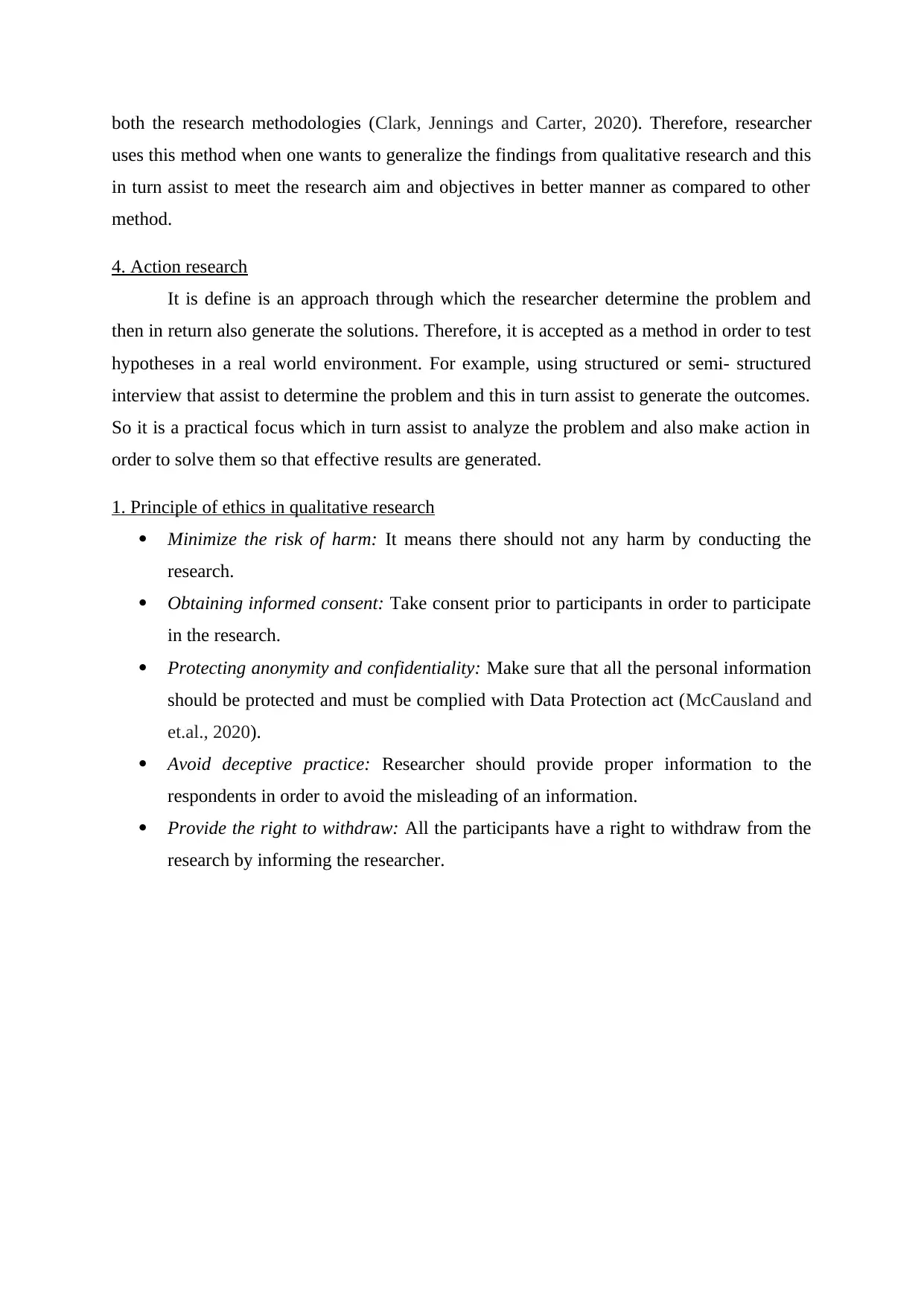
both the research methodologies (Clark, Jennings and Carter, 2020). Therefore, researcher
uses this method when one wants to generalize the findings from qualitative research and this
in turn assist to meet the research aim and objectives in better manner as compared to other
method.
4. Action research
It is define is an approach through which the researcher determine the problem and
then in return also generate the solutions. Therefore, it is accepted as a method in order to test
hypotheses in a real world environment. For example, using structured or semi- structured
interview that assist to determine the problem and this in turn assist to generate the outcomes.
So it is a practical focus which in turn assist to analyze the problem and also make action in
order to solve them so that effective results are generated.
1. Principle of ethics in qualitative research
Minimize the risk of harm: It means there should not any harm by conducting the
research.
Obtaining informed consent: Take consent prior to participants in order to participate
in the research.
Protecting anonymity and confidentiality: Make sure that all the personal information
should be protected and must be complied with Data Protection act (McCausland and
et.al., 2020).
Avoid deceptive practice: Researcher should provide proper information to the
respondents in order to avoid the misleading of an information.
Provide the right to withdraw: All the participants have a right to withdraw from the
research by informing the researcher.
uses this method when one wants to generalize the findings from qualitative research and this
in turn assist to meet the research aim and objectives in better manner as compared to other
method.
4. Action research
It is define is an approach through which the researcher determine the problem and
then in return also generate the solutions. Therefore, it is accepted as a method in order to test
hypotheses in a real world environment. For example, using structured or semi- structured
interview that assist to determine the problem and this in turn assist to generate the outcomes.
So it is a practical focus which in turn assist to analyze the problem and also make action in
order to solve them so that effective results are generated.
1. Principle of ethics in qualitative research
Minimize the risk of harm: It means there should not any harm by conducting the
research.
Obtaining informed consent: Take consent prior to participants in order to participate
in the research.
Protecting anonymity and confidentiality: Make sure that all the personal information
should be protected and must be complied with Data Protection act (McCausland and
et.al., 2020).
Avoid deceptive practice: Researcher should provide proper information to the
respondents in order to avoid the misleading of an information.
Provide the right to withdraw: All the participants have a right to withdraw from the
research by informing the researcher.
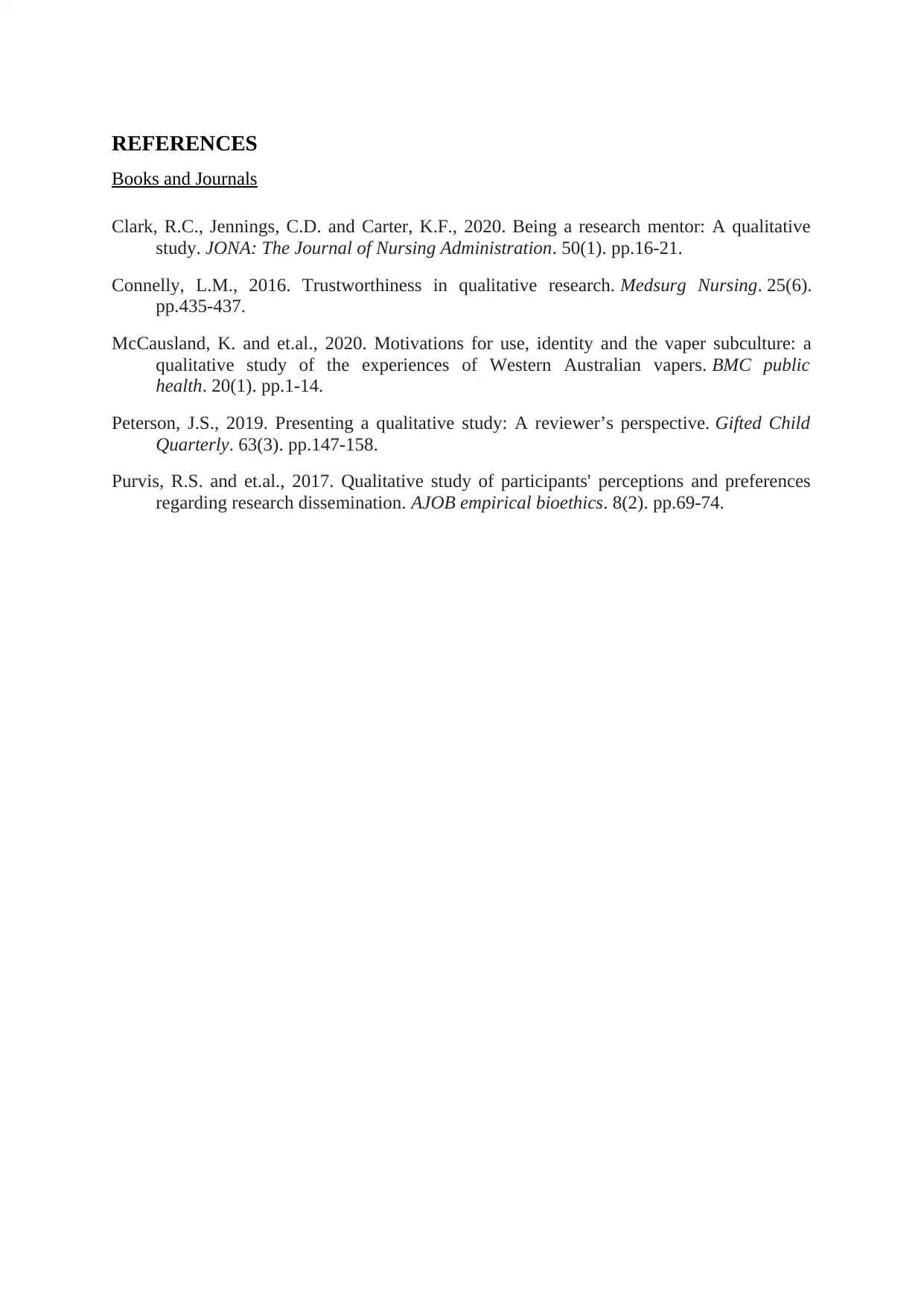
REFERENCES
Books and Journals
Clark, R.C., Jennings, C.D. and Carter, K.F., 2020. Being a research mentor: A qualitative
study. JONA: The Journal of Nursing Administration. 50(1). pp.16-21.
Connelly, L.M., 2016. Trustworthiness in qualitative research. Medsurg Nursing. 25(6).
pp.435-437.
McCausland, K. and et.al., 2020. Motivations for use, identity and the vaper subculture: a
qualitative study of the experiences of Western Australian vapers. BMC public
health. 20(1). pp.1-14.
Peterson, J.S., 2019. Presenting a qualitative study: A reviewer’s perspective. Gifted Child
Quarterly. 63(3). pp.147-158.
Purvis, R.S. and et.al., 2017. Qualitative study of participants' perceptions and preferences
regarding research dissemination. AJOB empirical bioethics. 8(2). pp.69-74.
Books and Journals
Clark, R.C., Jennings, C.D. and Carter, K.F., 2020. Being a research mentor: A qualitative
study. JONA: The Journal of Nursing Administration. 50(1). pp.16-21.
Connelly, L.M., 2016. Trustworthiness in qualitative research. Medsurg Nursing. 25(6).
pp.435-437.
McCausland, K. and et.al., 2020. Motivations for use, identity and the vaper subculture: a
qualitative study of the experiences of Western Australian vapers. BMC public
health. 20(1). pp.1-14.
Peterson, J.S., 2019. Presenting a qualitative study: A reviewer’s perspective. Gifted Child
Quarterly. 63(3). pp.147-158.
Purvis, R.S. and et.al., 2017. Qualitative study of participants' perceptions and preferences
regarding research dissemination. AJOB empirical bioethics. 8(2). pp.69-74.
⊘ This is a preview!⊘
Do you want full access?
Subscribe today to unlock all pages.

Trusted by 1+ million students worldwide
1 out of 6
Related Documents
Your All-in-One AI-Powered Toolkit for Academic Success.
+13062052269
info@desklib.com
Available 24*7 on WhatsApp / Email
![[object Object]](/_next/static/media/star-bottom.7253800d.svg)
Unlock your academic potential
Copyright © 2020–2025 A2Z Services. All Rights Reserved. Developed and managed by ZUCOL.




